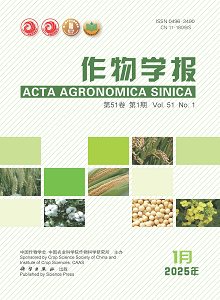覆盖垄沟雨水收集对宁夏南部干旱区土壤水热肥力及马铃薯产量的影响
引用次数: 1
摘要
目的探讨不同垄沟雨水覆盖方式对旱作马铃薯土壤水热肥力特性及产量的影响。2015年和2016年连续两年进行定位试验,在宁夏南部旱作农田设置了6种垄沟覆盖雨水收集模式。垄沟覆盖地膜,垄沟覆盖地膜(PP)、玉米秸秆(PS)、生物可降解地膜(PB)、韧皮纤维地膜(PF)、液体地膜(PL)、沟免覆盖(PN),以平植免覆盖为对照对照(CK)。研究了覆盖垄沟雨水收集对土壤水分、温度、养分和马铃薯产量的影响。覆盖垄沟集雨能显著提高全生育期0 ~ 200 cm土壤平均储水量,其中以PS处理的保水效果最好。与CK相比,PP处理显著提高了马铃薯生育期表层土壤温度(0 ~ 25 cm), PS处理显著降低了马铃薯表层土壤温度。与试验前相比,2年试验期间,不同垄沟雨水覆盖模式下0 ~ 40 cm土壤有机碳、全氮、碱解氮和速效磷含量均显著提高,土壤速效钾含量显著降低。与对照相比,不同垄沟雨水覆盖方式土壤养分均显著增加,其中PS处理土壤养分增幅最大。垄沟集雨覆盖能显著提高马铃薯产量和商品块茎率,其中以PS和PP处理最高,PB、PF和PL处理次之,PN和CK处理间差异不显著。相关分析和通径分析表明,土壤水分、有机碳和温度是限制马铃薯高产的重要因素。垄作地膜覆盖和垄作秸秆覆盖可通过改善旱地土壤水、温度和养分环境,显著提高马铃薯产量。在宁夏南部干旱地区马铃薯高产栽培中具有一定的应用价值。本文章由计算机程序翻译,如有差异,请以英文原文为准。
Effects of ridge-and-furrow rainwater harvesting with mulching on soil water- heat-fertility and potato yield in arid areas of southern Ningxia
: In order to explore the effect of different ridge-and-furrow rainwater harvesting with mulching patterns on soil wa-ter-heat-fertility properties and the yield of rainfed potato. A located experiment was conducted in 2015 and 2016 for two con-secutive years, and six ridge-and-furrow rainwater harvesting with mulching patterns were set up in dry farmland of southern Ningxia. Ridges were mulched with plastic film, while furrows were covered with plastic film (PP), maize straw (PS), biodegradable film (PB), bast fiber film (PF), liquid film (PL), and furrow without mulching (PN), and the flat planting without mulching was used as control check (CK). We investigated the effect of ridge-and-furrow rainwater harvesting with mulching on soil water, temperature, nutrients, and potato yield. Furrow-and-ridge rainwater harvesting with mulching patterns could significantly increase averag e soil water storage in 0–200 cm layer during the whole growth period, and PS treatment had the best effect on soil water conservation. Compared with CK, PP treatment significantly increased topsoil temperature (0–25 cm) during the growth period, while PS treatment significantly reduced topsoil temperature in potato. Compared with the treatment before the experiment, the contents of soil organic carbon, total nitrogen, alkali-hydrolysed nitrogen, and available phosphorus in 0–40 cm layer under different furrow-and-ridge rainwater harvesting with mulching patterns were significantly increased, while the soil available potassium contents were significantly decreased during the two-year experiments. Compared with the control, the soil nutrients with different furrow-and-ridge rainwater harvesting with mulching patterns were significantly increased with the largest increase in soil nutrients in PS treatment. Ridge-and-furrow rainwater harvesting with mulching patterns could significantly improve potato yield and marketable tuber rate, and PS and PP treatments were the highest, followed by PB, PF, and PL treatments, while there was no significant difference between PN and CK treatments. According to correlation and path analysis, the soil water, organic carbon, and temperature were the important factors limiting the high yield of potato. The ridge mulched with plastic film and furrow covered with straw could significantly increase potato yield by improving the soil water, temperature, and nutrient environ-ment in dryland. It had certain application value in high yield cultivation of potato in arid areas of southern Ningxia.
求助全文
通过发布文献求助,成功后即可免费获取论文全文。
去求助
来源期刊

作物学报
Agricultural and Biological Sciences-Agronomy and Crop Science
CiteScore
1.70
自引率
0.00%
发文量
89
期刊介绍:
The major aims of AAS are to report the progresses in the disciplines of crop breeding, crop genetics, crop cultivation, crop physiology, ecology, biochemistry, germplasm resources, grain chemistry, grain storage and processing, bio-technology and biomathematics etc. mainly in China and abroad. AAS provides regular columns for Original papers, Reviews, and Research notes. The strict peer-review procedure guarantees the academic level and raises the reputation of the journal. The readership of AAS is for crop science researchers, students of agricultural colleges and universities, and persons with similar academic level.
 求助内容:
求助内容: 应助结果提醒方式:
应助结果提醒方式:


